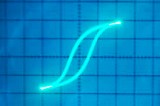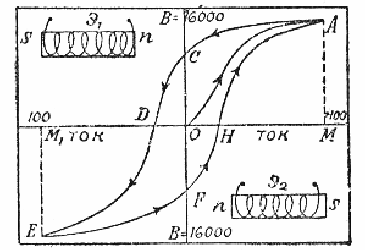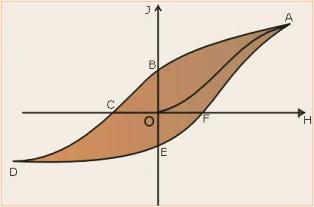What is hysteresis?
 In the core of any electromagnet, after the current is turned off, a part of the magnetic properties, called residual magnetism, is always preserved. The magnitude of the residual magnetism depends on the properties of the core material and reaches a higher value for hardened steel and less for mild iron.
In the core of any electromagnet, after the current is turned off, a part of the magnetic properties, called residual magnetism, is always preserved. The magnitude of the residual magnetism depends on the properties of the core material and reaches a higher value for hardened steel and less for mild iron.
However, no matter how soft the iron, the residual magnetism will still have some effect if, according to the operating conditions of the device, it is necessary to magnetize its core, that is, demagnetize to zero and magnetize in the opposite direction.
In fact, with each change in the direction of the current in the coil of the electromagnet, it is necessary (due to the presence of residual magnetism in the core) to first demagnetize the core, and only then it can be magnetized in a new direction. This would require some magnetic flux in the opposite direction.
In other words, the change in the magnetization of the core (magnetic induction) always lags behind the corresponding changes in the magnetic flux (magnetic field strength), created by the coil.
This lagging of the magnetic induction from the strength of the magnetic field is called hysteresis... With each new magnetization of the core, in order to destroy its residual magnetism, it is necessary to act on the core with a magnetic flux in the opposite direction.
In practice, this will mean spending some of the electrical energy to overcome the coercive force, which makes it difficult to rotate the molecular magnets to a new position. The energy spent on this is released in the iron in the form of heat and represents magnetization reversal losses or, as it is called, hysteresis loss.
Based on the above, iron subjected to continuous reversal of magnetization in a certain device (armature cores of generators and electric motors, transformer cores) should always be selected soft, with a very small coercive force. This makes it possible to reduce losses due to hysteresis and thus increase the efficiency of an electrical machine or appliance.
Hysteresis loop
Hysteresis loop — a curve depicting the course of the dependence of magnetization on the strength of the external field. The larger the area of the loop, the more work you have to do to reverse the magnetization.
Let us imagine a simple electromagnet with an iron core. Let's run it through a full magnetizing cycle, for which we'll change the magnetizing current from zero to the Ω value in the wallpaper directions.

Initial moment: the current is zero, the iron is not magnetized, the magnetic induction B = 0.
1st part: magnetization by changing the current from 0 to a value of — + Ω.The induction in the core iron will first increase rapidly, then more slowly. By the end of the operation, at point A, the iron is so saturated with magnetic lines of force that further increasing the current (over + OM) can give the most insignificant results, therefore the magnetization operation can be considered complete.
Magnetization to saturation means that the molecular magnets in the core, which at the beginning of the magnetization process were in a complete state and then only in partial disorder, are almost all now arranged in orderly rows, north poles on one side, south poles on the other. why do we now have north polarity at one end of the core and south at the other.
2nd part: weakening of magnetism due to reduction of current from + OM to 0 and complete demagnetization at current — OD. The magnetic induction changing along the AC curve will reach the value of OC, while the current will already be zero. This magnetic induction is called residual magnetism or residual magnetic induction. To destroy, for complete, therefore, demagnetization, it is necessary to give a reverse current to the electromagnet and bring it to a value corresponding to the ordinate OD in the drawing.
3rd part: reverse magnetization by changing the current from — OD to — OM1. The magnetic induction increasing along the curve DE will reach the point E corresponding to the moment of saturation.
4th part: weakening of the magnetism by gradually reducing the current from — OM1, to zero (residual magnetism OF) and subsequent demagnetization by changing the direction of the current and bringing it to the value + OH.
Fifth part: magnetization corresponding to the process of the first part, bringing the magnetic induction from zero to + MA by changing the current from + OH to + OM.
NSWhen the demagnetization current decreases to zero, not all elementary or molecular magnets return to their previous disordered state, but some of them retain their position corresponding to the last direction of magnetization. This phenomenon of delay or retention of magnetism is called hysteresis.

